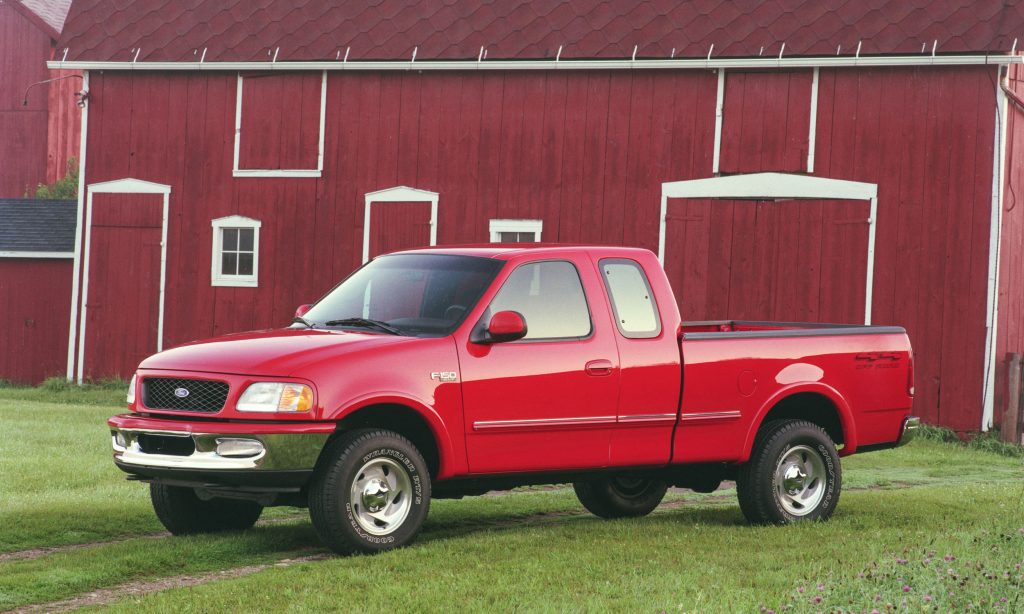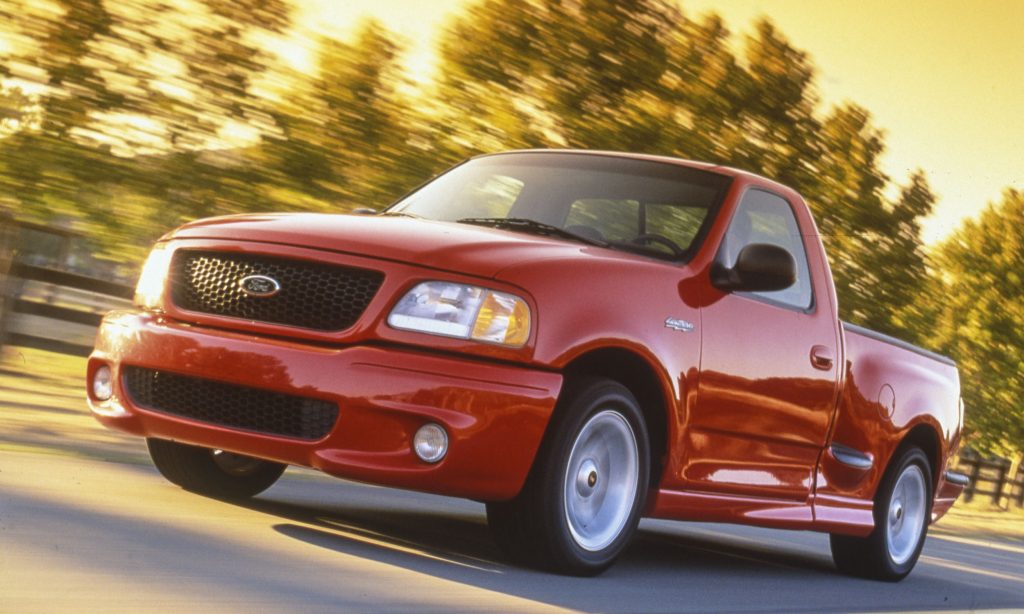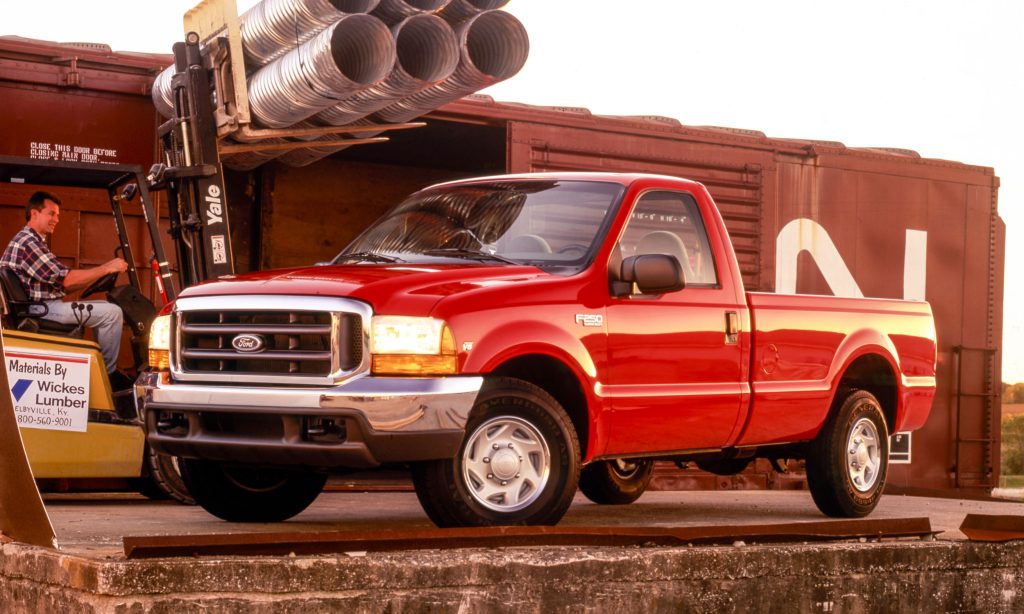For the most demanding pickup truck customers, the 2018 Ford F-Series Super Duty works harder…

Ford F-Series History Part2

Seventh Generation: 1980–1986
Focusing on economy and efficiency, Ford reengineered the F-Series for 1980 by making the overall design more aerodynamic for improved fuel economy, as well as reducing weight via the use of plastics, aluminum and lighter gauge steel where possible. In the middle of the gen-seven truck run, Ford offered its first diesel pickup: a 6.9-liter V8 diesel engine available in the 1983 F-250. In 1984 the F-100 was dropped and the F-150 became the base F-Series truck.

Eighth Generation: 1987–1991
The next-generation F-Series debuted as a 1987 model with new flush headlights that only required the bulb to be replaced rather than the entire headlight unit. The 1987 F-Series is the first truck to feature standard rear anti-lock brakes. The F-150 SuperCab was also offered with 4-wheel drive.

Ninth Generation: 1992–1996
The 1992 redesign continued to improve aerodynamics with smaller headlights that angle back toward the fenders. The front bumper angles back on the ends, and the exterior mirrors are more aerodynamic as well. Attempting to appeal to more sporty buyers, Ford premiered the F-150 Lightning for 1993, powered by a 240-horsepower 5.8-liter V8 with sport suspension, 17-inch alloy wheels and front spoiler. For 1994 a driver’s side airbag and door intrusion beams were added and 7.3-liter diesel engine was offered. The 1995 F-Series passed the Volkswagen Beetle as the world’s best-selling vehicle nameplate.

Tenth Generation: 1997–2003
The 10th generation F-Series features redesigned F-150 and light-duty F-250 models with a new lighter chassis. The SuperCab versions get the industry’s first standard third door for a pickup — a rear-hinged door on the passenger’s side that opens after the passenger’s main door opens, providing access to the rear of the cab. The F-Series was voted “North American Truck of the Year” by a panel of 47 automotive journalists, and was named “Truck of the Year” by Motor Trend magazine. The SuperCab received a second door on the driver’s side for 1999.

The SVT F-150 Lightning returned in 1999 as a regular cab stepside model, powered by a supercharged 5.4-liter V8 engine producing 360 horsepower and 440 lb-ft of torque. Power gets delivered to a limited-slip rear differential through a 4-speed automatic transmission borrowed from the Super Duty. SVT Lightning handling improvements include tuned sport suspension, Bilstein shocks and Goodyear tires

F-Series Super Duty
In 1999 Ford launched a new Super Duty line of medium-duty trucks built on an exclusive new frame. Ford’s decision to split the F-Series by chassis stemmed from a desire to increase payload and towing capacity of the F-250 Super Duty and F-350 Super Duty while improving and refining the best-selling F-150 at its own rate.

The first Harley-Davidson edition premiered as a 2000 model F-150 SuperCab with black monochromatic paint, a Flareside box and a hard tonneau cover. The F-150 H-D edition has 2-wheel drive, powered by a 5.4-liter V8 engine with a sport-tuned exhaust. The truck features lowered suspension, 20-inch 5-spoke cast aluminum wheels and P275/45R20 tires. The striking exterior has a special grille, chrome bars below the doors, a unique front valance with fog lights, stripes and Harley-Davidson badges. Inside, this special edition includes black leather seats, black leather trim, a spun-metal finish for the instrument cluster and Harley-Davidson badging

The F-150 SuperCrew joined the lineup for the 2001 model year, featuring four forward-hinged doors, more second-row passenger room than the SuperCab and a shorter pickup bed. The 10th generation F-Series saw a lot of significant additions to the line, including the premium King Ranch edition for 2001 and the second Harley-Davidson edition based on the F-150 SuperCrew; the third Harley-Davidson edition was added as a 2003 model. A 6.0-liter Power Stroke diesel joined the Super Duty lineup for 2003 as well

Eleventh Generation: 2004–2008
Larger than the previous version, the 11th-gen 2004 Ford F-Series has a taller grille and front fenders, and the sides of the bed are two inches taller. The regular cab and SuperCab are both six inches longer than the previous model for more rear-seat passenger room for the SuperCab. The regular cab offered storage room behind the seat and included small rear-hinged doors to access the storage room behind the seat. The SuperCab and the Crew Cab offered an optional power-sliding rear window.

Twelfth Generation: 2009–2014
The redesigned 2009 model features a more aggressive front-end appearance with a bigger, bolder grille similar to the style of the Super Duty. A new fully-boxed frame with hydro-formed and high-strength steel side rails makes the truck lighter but delivers more torsional rigidity for improved durability and comfort. Updates include higher output engines and a new 6-speed automatic transmission. The new top-of-the line Platinum trim increases the level of luxury offered in a pickup with 20-inch chrome wheels, a unique grille design, monotone paint, chrome accents, premium leather upholstery and heated/cooled seats. Regular cab models no longer have rear-hinged access doors.

A high-performance truck that looks like an off-road desert racer for the street, the F-150 SVT Raptor became part of the F-Series lineup for 2010. The SVT Raptor has an aggressive look derived from 7-inch wider track than a standard F-150, wider fenders, skidplates, hood vents, a raised ride height and a wide black grille with large FORD lettering in the center. Off-road performance equipment includes Fox Racing shocks, upgraded suspension with increased articulation, 17-inch alloy wheels, special 35-inch BFGoodrich all-terrain tires, an electronically locking rear differential and revised stability-control system for off-road use. The exterior features special graphics with sport seats inside. The SVT Raptor was initially powered by a 310-horsepower 5.4-liter V8 engine; a 400-horsepower 6.2-liter powerplant was added the following year

Thirteenth Generation: 2015–2020
The next-generation Ford F-150 debuted as a 2015 model and was Ford’s most technologically developed F-Series pickup to date. Extensive aluminum use allowed Ford engineers to drop 700 pounds of weight from the truck when compared to the previous model. The exterior look is both aggressive and refined, and underneath the new fully-boxed frame uses more high-strength steel to make it both stronger and lighter. Smart technology includes an available 360-degree camera view, available trailer-hitch-assist rear camera view, available remote tailgate with hands-free opening and available next-generation tailgate step. The 2015 F-150 debuted a new turbocharged 2.7-liter EcoBoost V6 with standard Auto Start-Stop — a lightweight, compact design that makes the same power as a midrange V8 engine.

For 2017 the F-150 added a new second-generation 3.5-liter EcoBoost V6 engine combined with an all-new 10-speed automatic transmission. The 3.5-liter EcoBoost includes twin port and direct injection, a redesigned turbocharger with electronic wastegate and new valvetrain to produce 375 horsepower and 470 lb-ft of torque. For 2018 the F-150 received exterior design updates throughout the model lineup including new grilles, bumpers, lighting, tailgates, exterior trim and wheels. Designers updated interiors for the XLT Sport, XLT Special Edition, Lariat, King Ranch, Platinum and Limited with new colors and materials. The standard engine became a new 3.3-liter normally aspirated V6 with port and direct-injection technology producing 290 horsepower and 265 lb-ft of torque, combined with an electronic 6-speed automatic transmission. Ford also added a 3.0-liter Power Stroke V6 diesel engine for the 2018 F-150 that produces 250 horsepower and 440 lb-ft of torque with peak torque at 1750 rpm.

The F-150 Raptor also returned for 2017, powered by a new high-output 3.5-liter EcoBoost engine producing 450 horsepower and 510 lb-ft of torque combined with a 10-speed automatic. Raptor also added a new clutch-based torque-on-demand transfer case that can automatically distribute torque between the front and rear axles, but also includes a mechanical lock for both 4-wheel-high and 4-wheel-low ranges. The wide-body 2017 Raptor has a 6-inch wider track, 2 inches more ground clearance and is 500 pounds lighter than the previous model. That Raptor also has upgraded FOX shocks, BF Goodrich KO2 tires and available 17-inch forged alloy bead-lock capable wheels.




Comments (0)